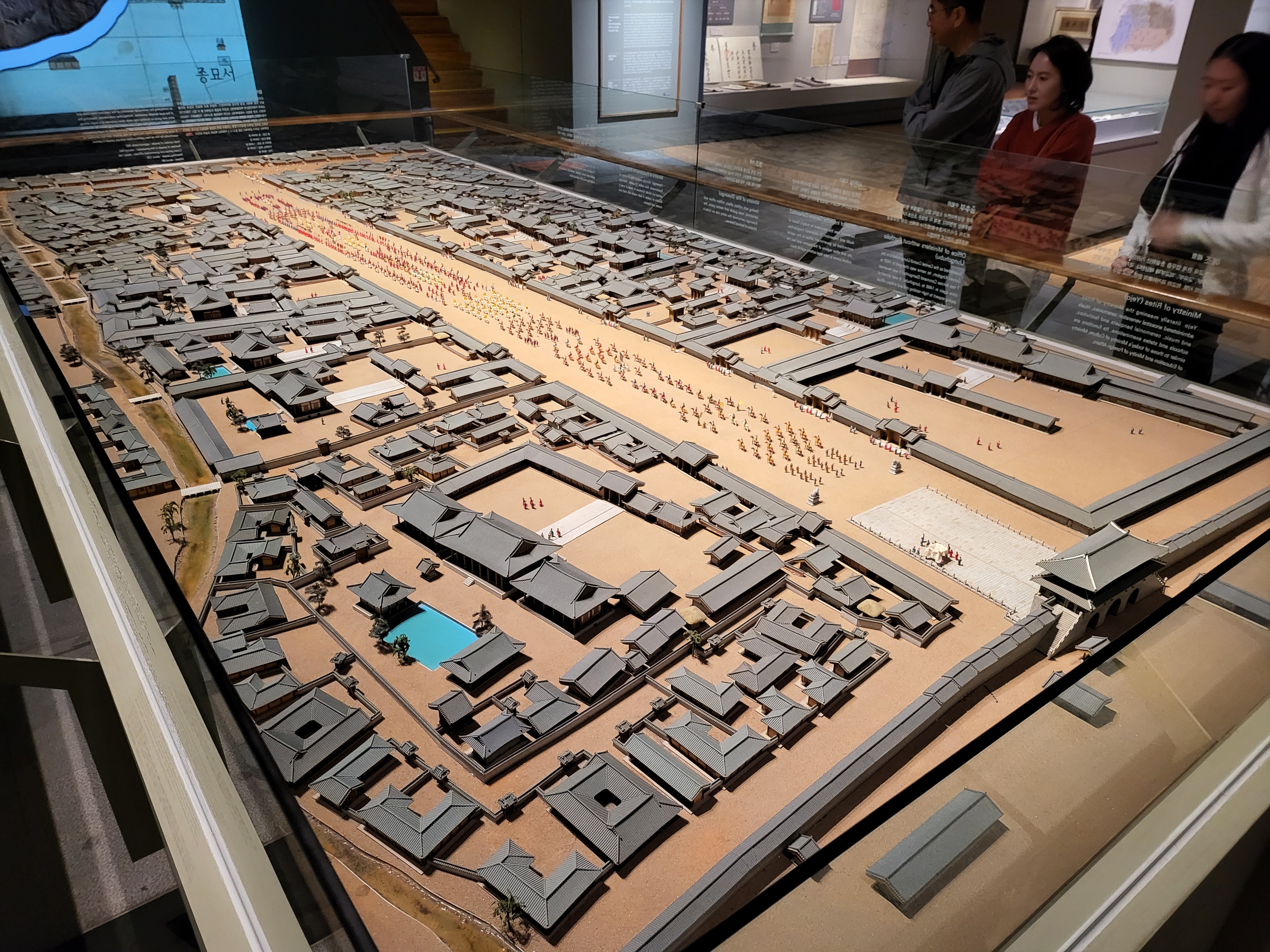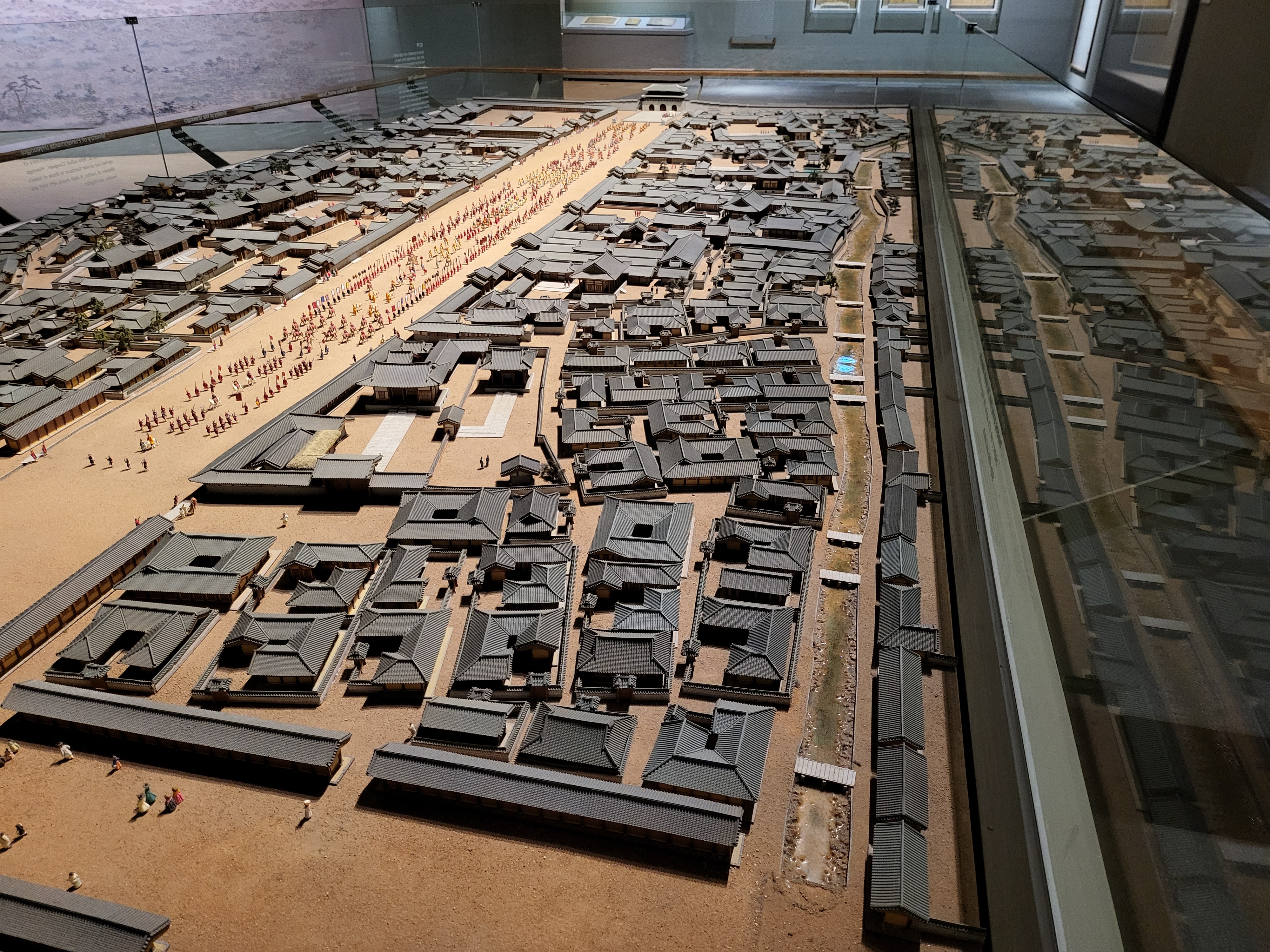
수도 한양은 유교적 도시계획의 기본원칙에 따라 계획되었습니다. 가장 먼저 왕이 거주하는 궁궐과 제사를 지내는 공간인 종묘·사직, 국가 통치를 위한 관청거리를 조성했습니다.
궁궐은 임금이 사는 공간이며, 신하가 임금을 뵙고 국가의 정책을 결정하고 선포하는 통치의 공간입니다. 따라서 한양의 도시구조는 궁궐을 축으로 형성되고 운영되었습니다.

경복궁 정문인 광화문 앞으로 나라에서 가장 큰 길을 내고 좌우에 의정부, 육조를 비롯한 국가 경영의 핵심 관청들을 배치하여 육조거리를 조성하였습니다.
육조거리는 궁궐과 연결되는 어가御街인 동시에 정치·행정의 중심지였으며, 조선 8도로 들고나는 모든 도로의 원점이기도 했습니다. 이로써 조선왕조 왕권의 상징이자 국가 통치의 중추 공간이 완성되었습니다.

Royal Palace and Yukjogeori Street: The Backbone of Joseon
The capital Hanyang was planned according to the basic principles of Confucian urban planning.
First to be established was the royal palace, serving as the king’s residence, followed by Jongmyo Shrine and Sajikdan Altar, serving as places for ancestral rites, and Yukjogeori Street, serving as a street for government offices.
The royal palace, as the king’s residence, was also a space of ruling where the king grants an audience to his retainers, and decided policies for the state.
Therefore, the urban structure of Hanyang was built and operated around the royal palace.
The country’s largest street was built in front of Gwanghwamun Gate, the front gate of Gyeongbokgung Palace. On either side of this street were located government offices (e.g. Euijeongbu, Yukjo), forming Yukjogeori Street. Yukjogeori Street was both a royal carriage connected to the royal palace as well as a political and administrative center.
It was also the starting point of all streets extending throughout Joseon.
The royal palace and Yukjogeori Street were symbols of the royal authority of Joseon and a pivotal space of the ruling state.

国家的中枢,宫殿与六曹街
首都汉阳依照儒教城市规划的基本原则设计而成。首先建造了君王居住的宫殿,其次是宗庙和社稷等祭祀空间,以及发挥国家统治作用的官府街道。宫殿是君王的生活空间,也是臣子觐见君王、决定宣布国家政策的统治空间。因此,汉阳的城市结构以宫殿为轴形成并运转。景福宫的正门, 光化门前修建有国家最大的街道,左右是以议政府、六曹为代表的国家经营核心官府,构成了六曹街。六曹街是连接宫殿的御街,也是政治、行政中心。往来朝鲜八道的所有道路均以此为起点。这里也因此成为了朝鲜王朝王权的象征,是国家统治的中枢空间。

国の中枢、宮闕と六曺通り
首都ハニャン(漢陽)は、儒教的都市計画の基本原則に従って計画されました。まず始めに、王が居住する宮殿と祭事を執り行う空間であるチョンミョ(宗廟)・サジク(社稷)、国統治のための官庁通りが設置されました。宮殿は王が住む空間であり、臣下が王と謁見して国の政策を決定・宣布する統治の空間です。そのため、ハニャン(漢陽)の都市構造は、宮殿を軸として形成され運営されました。キョンボックン(景福宮)の正門クァンファムン(光化門)の前に国で最も大きな道をつくり、左右にウィジョンブ(議政府)、六曺をはじめとする国家経営の中心官庁が配置され、六曺通りが設けられました。六曺通りは、宮殿と連結する御街であると同時に政治・行政の中心地であり、朝鮮八道へつづくすべての道路の原点でもありました。こうして、朝鮮王朝王権のシンボルであり、国家統治の中枢となる空間が完成されました。

'역사문화 이모저모' 카테고리의 다른 글
| 조선시대 한양도성 안 마을 (0) | 2023.10.29 |
|---|---|
| 한양의 궁궐들 (0) | 2023.10.29 |
| 수도방위체제의 확립과 경도京都 - 사도四都체제 (0) | 2023.10.29 |
| 신라 화랑은 오두미도 도교 교단 지도자 (0) | 2023.10.29 |
| 정창원 고문서 제첨축 보며 자아비판한다 (0) | 2023.10.28 |




댓글